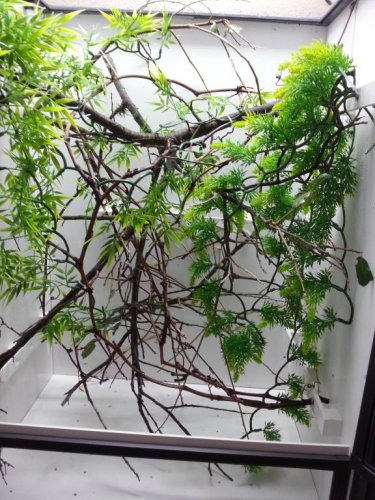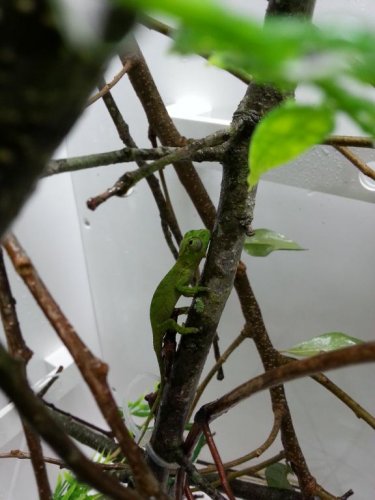jajeanpierre
Chameleon Enthusiast
Yesterday one baby had pipped, and this morning s/he is hatched. Very excited and very, very scared--there can't be anything worse than a novice with a rare hatchling--a montane species to complicate it even more--so any tips will be greatly appreciated. Laurie is giving me tons of advice and a few other quad breeders are helping/have helped a lot.
This clutch is from a gracilior female who was gravid when imported in February. She's since laid a clutch of infertile eggs and has now been bred to my gracilior male.
No other eggs seem to have pipped or sweated this morning. I didn't notice this baby's egg ever sweating. Two or three of the eggs this morning seem to have patches of grey splotches--the same color the hatching egg turned after it had pipped, a sort of grey color. I hope that is just normal thinning of the egg or whatever else goes on before hatch. I can't see any others pipping, but some eggs are pretty deep in the vermiculite so I might not see the first signs of pipping. Eggs are five days past the 5-month mark, so well within the normal range.
I left baby in the incubator with the other eggs. S/he's not moving around, just sitting in a corner but looks to be a good weight and alert. Picture attached. If s/he had hatched in the wild, I think s/he would still be stuck underground because there wouldn't be her clutch mates helping dig out. Don't know if it is true, but I've heard that the movement of other clutch mates stimulates unhatched eggs to start to hatch. Can't hurt and at least I know the environment in the incubator is good. I'm terrified to put her in a cage.
I think I have lots of fruit flies and some bean beetles. Laurie recommended I order pinhead crickets Monday. I'll order the next size up, too. How many do I order? If all the eggs hatch, I'll have 12 baby graciliors.
I'll put them in a Dragonstrand extra wide breeder-series cage. It's only 30"tall,but the same footprint as the largest breeder cage. I'll change out the doors to Dragonstrand's new clear film doors so I can keep the humidity really high. The floor will be bare and the cage filled with fresh oak twigs/branches. I'm debating live plants. I do have plastic plant vines and things. Thoughts on the plants? The cage will be on a bottom shelf near the floor (so the coolest part of the room) and the Arcadia lights will be about 18" above the top of the cage. There shouldn't be a heat build up from the lights. I also have pieces of plastic with holes punched in it that Light Your Reptiles sent me to test out. It will reduce the UVB by 50% if it proves too high. My light meter shows almost no UVB except at the very top of the cage. I also have Reptisun compact UVB lights.
The cage will be hooked up to my automatic mister which currently is run six times a day:
8:00 a.m. 2 minutes
10:00 a.m. 5 mintues
1:00 p.m. 3 minutes
3:00 p.m. 3 minutes
5:00 p.m. 2 minutes
7:00 p.m. 30 seconds
I can have up to 8 automatic settings on the mister. What schedule would be better? There might not be any live plants in the cage to hold moisture. I'll arrange the perching so no baby can be near the (single) nozzle.
I think I have everything covered--humidity, lighting, food and caging. I'm not sure on whether to put in live plants (have not been able to find what I want yet) or plastic. What am I missing or could do better?
Thanks for all your help.
This clutch is from a gracilior female who was gravid when imported in February. She's since laid a clutch of infertile eggs and has now been bred to my gracilior male.
No other eggs seem to have pipped or sweated this morning. I didn't notice this baby's egg ever sweating. Two or three of the eggs this morning seem to have patches of grey splotches--the same color the hatching egg turned after it had pipped, a sort of grey color. I hope that is just normal thinning of the egg or whatever else goes on before hatch. I can't see any others pipping, but some eggs are pretty deep in the vermiculite so I might not see the first signs of pipping. Eggs are five days past the 5-month mark, so well within the normal range.
I left baby in the incubator with the other eggs. S/he's not moving around, just sitting in a corner but looks to be a good weight and alert. Picture attached. If s/he had hatched in the wild, I think s/he would still be stuck underground because there wouldn't be her clutch mates helping dig out. Don't know if it is true, but I've heard that the movement of other clutch mates stimulates unhatched eggs to start to hatch. Can't hurt and at least I know the environment in the incubator is good. I'm terrified to put her in a cage.
I think I have lots of fruit flies and some bean beetles. Laurie recommended I order pinhead crickets Monday. I'll order the next size up, too. How many do I order? If all the eggs hatch, I'll have 12 baby graciliors.
I'll put them in a Dragonstrand extra wide breeder-series cage. It's only 30"tall,but the same footprint as the largest breeder cage. I'll change out the doors to Dragonstrand's new clear film doors so I can keep the humidity really high. The floor will be bare and the cage filled with fresh oak twigs/branches. I'm debating live plants. I do have plastic plant vines and things. Thoughts on the plants? The cage will be on a bottom shelf near the floor (so the coolest part of the room) and the Arcadia lights will be about 18" above the top of the cage. There shouldn't be a heat build up from the lights. I also have pieces of plastic with holes punched in it that Light Your Reptiles sent me to test out. It will reduce the UVB by 50% if it proves too high. My light meter shows almost no UVB except at the very top of the cage. I also have Reptisun compact UVB lights.
The cage will be hooked up to my automatic mister which currently is run six times a day:
8:00 a.m. 2 minutes
10:00 a.m. 5 mintues
1:00 p.m. 3 minutes
3:00 p.m. 3 minutes
5:00 p.m. 2 minutes
7:00 p.m. 30 seconds
I can have up to 8 automatic settings on the mister. What schedule would be better? There might not be any live plants in the cage to hold moisture. I'll arrange the perching so no baby can be near the (single) nozzle.
I think I have everything covered--humidity, lighting, food and caging. I'm not sure on whether to put in live plants (have not been able to find what I want yet) or plastic. What am I missing or could do better?
Thanks for all your help.









